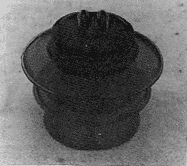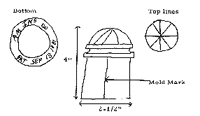Letters to the Editor
Reprinted from "INSULATORS - Crown Jewels of the Wire",, June 1970, page 16
From Hugh D. Summers:
I wonder how many of your readers are collecting the old radio aerial
insulators that used to be installed outdoors, from a tree or a hole before the
built-in antennas. I have six of these, one each of glass in these colors:
honey amber, S.C.A., aqua and clear, and several in white and brown
porcelain. They were made in many shapes and sizes. They make a nice
add on.

From Chris Buys:
Really enjoyed your last issue, received it today. But, oh my, I must have
goofed in describing the big green French power insulators??? (Crown Jewels of
the Wire, April 1970, page 24) 131 lbs. and 8 feet by 7 feet ---- yewowow. No
doubt I was typing late and just didn't pay close attention to what I was
doing. Boy did my wife and I laugh about it, but very sorry to lead you
and your readers astray.

Enclosed is a picture of the 13 pound French insulators that is about 8
inches by 7 inches. Again, very sorry I did that to you, and
hope it won't cause you any undo letter answering.
From Charles Barnes:
We read your book each month from cover to cover with much interest. I
have found about 35 different varieties and types in the last few months.
I have some insulators that are not listed in Milholland's No. 2. One is
pony size with four lines running across the crown to the wire groove (CD
105). The groove lips are square and on the inside the crown at the top of
the threads is a tapered point 1/4" which would protrude into the pin.

I also have signal insulators (CD 162) with Wm BROOKFIELD, 83 Fulton St., New
York on crown and PATD NOV 13th 1883 on skirt. I wonder how often you find
Wm and 83 Fulton St. on them?
I also found one signal (CD 133.1) with no name and PAT APP FOR and a number
"3" on the skirt. This is a blue insulator. How often did
they put this on an insulator?
I have a few more which are not listed in the book. I will write about
them later if you are interest.
I went back and looked in the same area and found another (pony) (CD 105)
near where I found the first one. It was a little different than the first
as it has three dotted lines and one solid line, instead of four solid
lines. The one with the dots in mint and the one with the solid lines has
two small chips.
 
Do you have any history of the American Insulator Co.? It would be
interesting to see some history of these small insulator companies in your book.
Letter from Jerry Witulski:
I just received "Crown Jewels" today and like usual have read it cover to cover.
There are two things in it I think you would be interested in. First, there is an article
about the Denvers and in it they talk about large power insulators made by Good but
none have been found. In my and my friendís opinion many have been found... the
Mershons (CD 288).
There are many reasons why we believe that these were made by Good:
lst: Ralph D. Mershon was issued his patent no. 605,256 on June 7, 1898, in Colorado Springs
(the same date as Locke's sleeve patent no. 605, 109). The only glass manufacturer at
that time within a reasonable distance manufacturing insulators was Good.
2nd: The color is about the same.
3rd: Most Mershons have been found in Colorado and surrounding states.
4th: Where are the power "Goods" if Mershons were not made by them?
Also, both the W. G. M. Co pony (CD 106) and Bullet (beehives to you, we call them
bullets - CD 134) have been found in clear or with a very light tint of purple.
Second, in questions to Mr. Woodward, the #2 answer ("INSULATORS - Crown Jewels of the Wire",
January 1970, page 21)says that he has no reason to say "yes" so he says "no." I think I have definite proof that Brookfield
had something to do with B. G. M. Co. I was checking antique shops near my home one day and in one antique shop the man had a light blue-green double beehive
that had some chips around the base that to him were so bad he gave it to me. Well,
a few days later, a fellow collector friend of mine saw some lettering under one
of the B's and we were trying to figure out what it was but it was hard because one of
the chips went up to part of the lettering. Then on the weekend we had a small
informal showing of our insulators and Sidney J. White, who you mentioned in the Denver article, was looking at it under a magnifying glass and thought it
said B.G. M. Co. and if you were to imagine that the chip were not there that is what
it would say.
P. S. About Denvers: ("INSULATORS - Crown Jewels of the Wire", January 1970, page 13), the W. F. G. Co. CD 134 I
have seen is smoky, yellow, silver and silver-blue; the W. F. G. Co. CD 162 has been found in silver.
| 